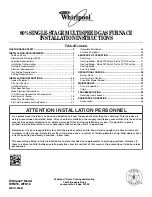
SYSTEM OPERATION
35
HEATING - Abnormal Operation
The following presents the probable causes of questionable
furnace operation and how to fix them. Look through the ob
-
servation window in the blower access door and make a note
of the number of flashes in sequence between pauses. Next,
refer to the
Troubleshooting Chart
on the following pages for
an interpretation of the LED signals and to the information in
this section for a description of the problem.
1.
Internal Control Failure with Integrated Ignition
Control.
Check for voltage to the furnace and low volt-
age at the control board. Check for blown fuse on the
control board. If the control determines it has an internal
fault, it enters a locked-out state. Any of the situations
mentioned will cause the diagnostic LED to provide
no
signal.
The control board should only be replaced after
all other checks from the
Troubleshooting Chart
have
been verified.
2.
System Lockout.
If a flame is not sensed during the first
seven (4) seconds after the gas valve is energized, the
control turns off the gas. There will then be a 30 second
delay while the induced draft blower is energized to purge
the heat exchanger. The ignitor will next be energized
and preheated for (8) seconds. The gas valve will then
be energized. If flame is not sensed in seven (4) seconds
the gas valve will be de-energized and another purge
will occur. The control will cycle the gas valve a total of
three (3) times before it determines it cannot establish
measurable combustion and enters a locked out state.
The diagnostic light code for this problem is
one short
flash
followed by a longer pause. The control can be
reset and brought out of lockout mode by turning the
thermostat off for more than (5) seconds and less than
(20) seconds and then back on. It can also be reset by
turning off the electrical disconnect switch to the furnace
for a minimum of 5 seconds.
NOTE:
The control board will automatically reset one hour
after lockout occurs. If the furnace frequently has to be reset,
it means that a problem exists that should be corrected. Refer
to
Troubleshooting Chart
on the following pages for aid in
determining the cause.
3.
Pressure Switch Stuck Closed.
If the control senses the
pressure switch is closed when the induced draft blower
is off, it waits until the fault is corrected. The diagnostic
light code for this problem is
two short flashes
followed
by a longer pause. The probable cause is either a faulty
pressure switch or wiring.
4.
Pressure Switch Stuck Open.
If, after the induced
draft blower is energized, the pressure switch does not
close within 5 minutes, the control will go into a 1-hour
lockout. The control will automatically reset from lockout
adn restart the ignition sequence. The diagnostic light
code for this problem is
three short flashes
followed by
a pause. The probable causes are either disconnected
hose to the pressure switch, faulty pressure switch or
wiring, or restricted air intake or flue piping.
5.
Open Primary Limit.
If the limit control opens, the air
circulator blower will be turned on until the limit closes.
The induced draft blower will turn off for 5 seconds then
turn off. The diagnostic light code for this problem is
four short flashes
followed by a pause. The probable
cause is either low conditioned air flow due to dirty filter
or resistance in duct work, faulty limit, faulty blower, or
blower speed set to low.
6.
Flame Sensed with No Call for Heat.
If the control
senses a flame when the gas valve is de-energized, it
will run the air circulation blower and the induced draft
blower continuously with no further furnace operation.
The diagnostic flash code for this is a
five flashes
. The
probable causes are either a short to ground in flame
sense circuit, miswiring, lingering burner flame or a slow
closing gas valve.
7.
Open Rollout Limit.
If the rollout control opens, the air
circulator blower will be energized all the time. The diag-
nostic light code for this problem is
six flashes
followed
by a pause. The probable cause is either restricted flue
piping or improper air requirements.
8.
Low Flame Sense Signal.
If the furnace continues to
operate and the micro-amp signal from the flame sensor
falls below specified level, the diagnostic light code for
this problem will be
seven flashes
followed by a pause.
The probable cause is either a coated/oxidized sensor,
incorrectly positioned senser in burner flame or lazy burn
-
er flame due to improper gas pressure or combustion air.
9.
Igniter circuit or poor ground.
Improperly connected
igniter, bad igniter or poor ground to the equipment. The
diagnostic light code for this problem is
eight flashes
.
(PCBBF145 Control Board)
















































